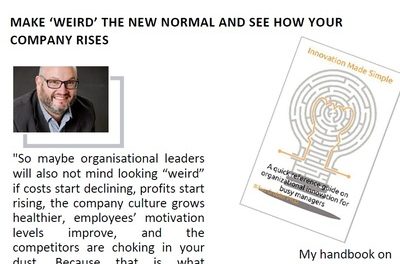
The lost art of brainstorming – follow these simple rules and you are guaranteed success

By Rikus Grobler, www.nis.co.na, [email protected].
In the previous delivery I looked at some of the better-known problem solving techniques. I delved a bit deeper into Creative Problem Solving (CPS) and one of the steps in CPS is the idea generation phase. There are many idea generation techniques available, and I have had my share of testing out a few of these, and all I can say is that some are definitely better than others.
It is also a case of horses for courses, since environments and circumstances differ and some techniques are better suited to the purpose for which it has been developed. I mean, it is different scenarios searching for and fixing bugs in computer software or trying to find a way to build a bridge in a very challenging environment or finding a solution to a specific frustration a customer has with your product or service.
In the typical organisational setting however, most challenges are usually faced by and solved by a team or a group of people. How this is usually done in the absence of any specific applied methodology is through ordinary discussion. Just think for a moment how many times have you or your team come up with a solution to a problem by merely discussing it and throwing ideas and suggestions around.
That is why I like brainstorming. In my opinion it is just a more formalized manner of our “default” setting for solving problems or coming up with ideas. I have dealt with the “how” of brainstorming in previous articles, and there are a lot of information available on the Internet on this method, so I do not want to repeat it. But I really value this technique, hence I want to concisely list the ground rules of brainstorming and then I would also like to make you think about the criticism against brainstorming and how to solve it.
Brainstorming is dead, long live brainstorming!
The foundational rules of group brainstorming are the following:
1. Focus on quantity: The greater the number of ideas generated, the greater the chance of producing a radical and effective solution.
2. Withhold criticism: By suspending judgement until after the idea generation phase, participants will feel free to generate unusual ideas.
3. Encourage wild ideas: Wild ideas make people laugh, and laughter stimulates creative thinking. 4. Combine and improve ideas: Good ideas may be combined to create better ideas.
Looking at these rules, it is not hard to figure out the biggest criticism against brainstorming. This is usually a mixture of the following:
1. Lack of preparation. You can’t just call a meeting and ask people to brainstorm without any preparation.
2. Lack of focus. Proceeding with a poorly defined topic.
3. Judging every idea as it is put forward.
4. Letting a few participants dominate the discussion.
5. Lack of structure. Creativity without structure produces a formless mess.
6. Fear of being wrong or stupid.
7. Brainstorming done poorly by unskilled facilitators.
The solutions to most of these criticisms are obvious, but also consider the following suggestions for getting the most out of a brainstorming session, based on my learnings and a combination of tips I filtered from the 300 articles on brainstorming in my library. I will keep it to the ten that I have found the most meaningful:
1. Do your homework before the actual brainstorming session. Research background information and gather data on customers, the marketplace, and competition, etc. Identify the needs and motivations of your end-users. Collect stories about what works, and what drives people crazy. Make sense of your research by looking for patterns, themes, and larger relationships between the information, and extracting key insights.
2. Invite people for both content and for decision-making reasons.
3. Invite also a couple of outsiders as outside-the-box thinkers.
4. Do not allow ringing and flashing mobile phones (easier said than done).
5. Do not brainstorm at the office.
6. Hire visualisers or cartoonist to visualise the results (this raises the cost, but I have experienced this first-hand and it is absolutely awesome!).
7. Keep the pace going; otherwise it becomes long-winded and boring.
8. Be open to suggestions from the group to adapt the process. Do not always try to stick to the programme you have set.
9. Use a (skilled) outside facilitator.
10. Follow up quickly. Decisions and other follow-up activities should be quick and thorough. The odds that concrete action will result from an idea generation exercise tend to decline quickly as time passes and momentum fades.
There are without doubt naysayers to brainstorming, but I am a big fan of this technique. To establish a successful brainstorming or idea generation session goes far beyond dumping people into a room. Poorly planned, poorly led and poorly executed brainstorming doesn’t work, just like poorly led firms with little strategy are often unsuccessful. If it is done right, I’ll guarantee a successful result – you’ll see a dramatic difference in your idea generation.
Next Time
I have recently come across a few “alternative” brainstorming techniques which I have found very intriguing, so I would like to share some of these in the next delivery.
I conclude with a quote from Apoki Charles with which I wholeheartedly agree: “Great ideas are like expensive wines. They are best enjoyed when shared . . . especially with those who have value for them.”













































